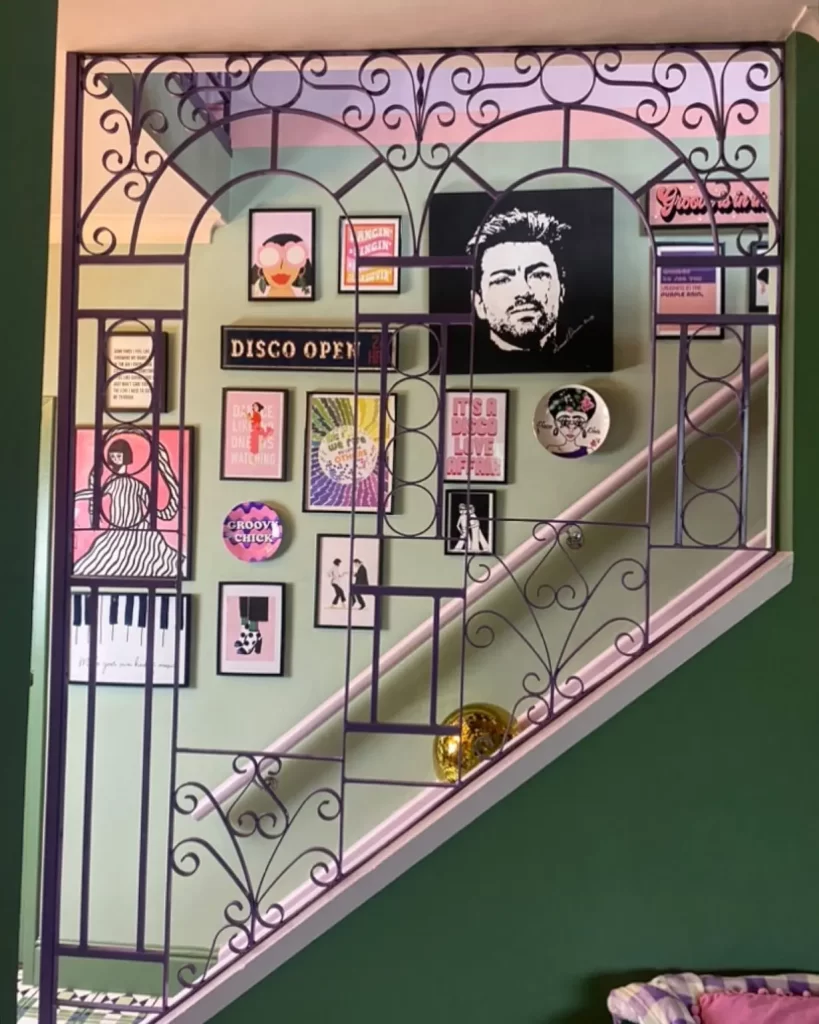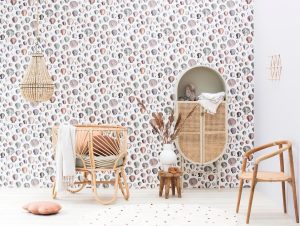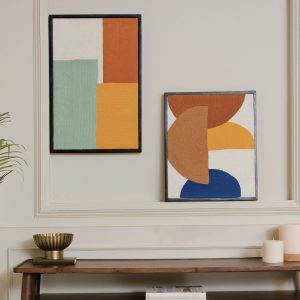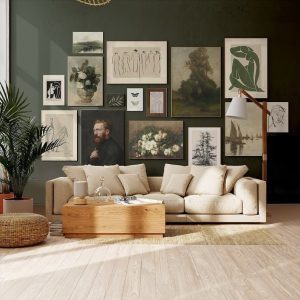‘How to Avoid Common Mistakes When Creating a Gallery Wall‘ offers valuable insights for anyone looking to enhance their home with a personal touch.
A well-designed gallery wall not only adds character and warmth to your living space but also allows you to showcase your artistic flair and personal memories.
However, the process can be fraught with potential pitfalls that might detract from the overall beauty of the display.
This blog post will navigate you through the essentials of planning and executing a gallery wall, providing practical tips to sidestep common errors.
Thus, ensuring that your wall is as stunning as it is meaningful.
From choosing the right pieces to perfecting the arrangement, let’s explore how to create a gallery wall that truly shines.
The Fundamentals of Gallery Wall Design

What is a Gallery Wall?
A gallery wall is more than just a collection of frames on a wall; it’s a creative expression of one’s personality, experiences, and aesthetic preferences. Typically, it involves a carefully selected arrangement of various items including photographs, artwork, and sometimes even three-dimensional objects, all designed to tell a story or create an impactful visual display.
Essential Elements of a Gallery Wall
To embark on creating a gallery wall, you need to understand its essential components:
- Frames: The choice of frames can significantly affect the overall look. Consider different materials, finishes, and sizes.
- Artworks: These can range from prints and photographs to canvases and handmade pieces. The art should reflect your personal style and bring cohesion to the collection.
- Layouts: The arrangement of the frames and artworks can follow numerous patterns, each offering a different vibe – from structured grids to dynamic, eclectic styles.
Proper Planning to Avoid Common Mistakes When Creating a Gallery Wall
Visualizing the End Result
Before hammering a single nail, it’s crucial to envision what you want your gallery wall to look like. Tools such as digital apps and software can help you simulate the arrangement before making any permanent decisions. This step is vital in ensuring that the end result aligns with your vision and fits the available space.
Choosing the Right Wall
Selecting the ideal wall for your gallery is as important as the pieces you choose to display. Consider:
- Lighting: Natural and artificial lighting can dramatically affect the appearance of your artwork.
- Visibility: The wall should be in a space where it can be appreciated, ideally a focal point in the room.
- Space: Ensure the wall is large enough to accommodate your planned layout without feeling cluttered or overwhelming.
Selecting Your Pieces
The art and frames you choose should complement each other, creating a balanced look.
Here are some tips:
- Variety and Balance: Mix different sizes and orientations of art to create interest. Maintain harmony by offsetting larger pieces with smaller ones.
- Color Scheme: Stick to a coherent color palette to ensure the wall feels unified.
- Personal Touch: Include pieces that have personal significance or evoke joy, making your gallery wall uniquely yours.
Engaging Layout to Avoid Common Mistakes When Creating a Gallery Wall
Creating an appealing gallery wall isn’t just about selecting beautiful pieces; it’s also about how these pieces are laid out. A well-thought-out arrangement can enhance the visual impact, while common layout mistakes can detract from the overall appearance.
Here’s how to avoid these pitfalls and ensure your gallery wall is both balanced and engaging.
Layout Techniques
Understanding different layout techniques is crucial in creating an effective gallery wall:
- Symmetrical vs. Asymmetrical Layouts:
- Symmetrical: This layout is characterized by mirrored arrangements where the spacing and size of artwork are uniform. It offers a formal, balanced look suitable for traditional interiors.
- Asymmetrical: More dynamic and modern, this approach involves varying sizes and spacing, allowing for more creativity and personal expression. It can be trickier to balance but often results in a more organic and interesting display.
- Spacing and Alignment Tips:
- Consistent Spacing: Keep the space between each frame consistent. Typically, 2-3 inches between each frame works well, providing enough room to distinguish each piece while maintaining a cohesive look.
- Vertical and Horizontal Lines: Align your frames either along their tops, bottoms, or centers. This creates a clean, intentional appearance even if the artworks are different sizes.
Installation Tips
Proper installation is key to ensuring your gallery wall looks professional and remains secure:
- Tools and Methods:
- Use the Right Hardware: Depending on the weight of your frames, choose appropriate hanging hardware. Drywall anchors, picture hooks, and nails are common options.
- Level and Measure: Use a level to ensure your pictures hang straight. Measuring tapes and rulers are essential to maintain even spacing and alignment.
- Paper Templates: Before drilling holes, consider using paper templates. Tape the shapes of your frames on the wall to visualize the final arrangement. This allows you to experiment with different layouts without damaging your wall.
- How to Avoid Damage to Walls:
- Adhesive Strips: For lighter frames, adhesive strips can hold artwork securely without the need for nails, minimizing wall damage.
- Rails or Hanging Systems: Installing a rail system allows you to adjust and expand your gallery wall without additional holes.
Advanced Design Tips to Avoid Common Mistakes When Creating a Gallery Wall
Taking your gallery wall from good to great involves a deeper understanding of thematic coherence and the strategic use of diverse media and textures. These advanced design tips will help you elevate the sophistication and impact of your display.
Theming Your Gallery Wall
Choosing a theme for your gallery wall can tie the elements together into a cohesive narrative, making the overall effect more striking and intentional.
- How to Choose a Theme:
- Personal Interests: Reflect on themes that resonate with your personality or interests, such as nature, urban landscapes, or abstract art.
- Decor Style: Align your theme with the existing decor style of your room. For instance, a vintage-themed gallery wall can complement a rustic interior, while a minimalist approach works well in modern spaces.
- Color Schemes: Select artworks that share a common color palette to create visual unity and flow.
- Examples of Popular Themes:
- Travel Memories: Showcase a collection of photographs and artifacts from different travels, creating a wall that tells the story of your adventures.
- Family Heritage: A mix of old family photos, heirlooms, and hand-written letters can create a deeply personal and emotional theme.
- Artistic Exploration: Feature a variety of art forms from a particular artist or art movement that inspires you.
Mixing Media and Textures
Incorporating a variety of media and textures can add depth and intrigue to your gallery wall, making it a dynamic focal point of the room.
- Benefits of Variety:
- Visual Interest: Different textures and materials catch light uniquely and add layers to your display, making it more engaging.
- Depth Perception: Mixing elements like flat prints with raised or textured pieces can give your gallery wall a three-dimensional look.
- Ideas for Mixing Elements Effectively:
- Combine Art Forms: Mix paintings, drawings, prints, and textile art. The variation in medium can highlight each piece’s unique qualities.
- Incorporate Objects: Beyond traditional framed pieces, consider adding items like small shelves holding sculptures, vintage clocks, or even plants.
- Texture Variety: Include elements with distinct textures, such as a woven tapestry or a shadow box, to create tactile diversity.
Maintaining and Updating Tips to Avoid Common Mistakes When Creating a Gallery Wall
A gallery wall is not just a static feature of your home décor; it’s a dynamic part of your living environment that can evolve with your tastes and life changes. Maintaining and updating your gallery wall ensures it remains fresh, relevant, and visually engaging. Here’s how you can keep your gallery wall in top condition and adapt it to reflect new inspirations and experiences.
Caring for Your Gallery Wall
Regular maintenance is key to preserving the look and longevity of your gallery wall. Here are some tips to help you care for your display effectively:
- Dust and Clean Regularly: Dust frames and artwork gently with a soft cloth or a duster. For glass-covered pieces, use a glass cleaner to remove fingerprints and smudges without leaving streaks.
- Protect from Sunlight: Avoid direct exposure to sunlight, which can fade artwork over time. If your gallery wall receives a lot of natural light, consider using UV-protective glass in your frames.
- Monitor Humidity Levels: High humidity can damage artworks and frames. Maintain a moderate humidity level in your room to prevent warping and other moisture-related damage.
When and How to Update Your Gallery Wall
Refreshing your gallery wall can keep your space exciting and personally meaningful. Consider these occasions and methods for updating your arrangement:
- Seasonal Changes: Rotate artworks according to seasons for a fresh look. Seasonal themes can bring new energy and relevance to your space.
- Life Milestones: Incorporate new items that represent significant life events, such as weddings, graduations, or travel, to keep your wall reflecting your current life journey.
- Style Shifts: As your interior design tastes evolve, update your gallery wall to match new aesthetics or color schemes. This keeps your living environment harmonious and stimulating.
- Simple Updates for Big Impact:
- Rearrange Existing Pieces: Sometimes, simply changing the arrangement of your current artworks can breathe new life into the space.
- Add or Replace One or Two Pieces: Introducing new pieces or swapping out older ones can significantly alter the mood and style of your gallery wall without a complete overhaul.
Solving Common Gallery Wall Challenges
Creating a gallery wall can be a rewarding project, but it’s not without its challenges. Here are some of the most common issues people encounter when designing their gallery walls, along with practical solutions to overcome them.
Balancing Asymmetrical Layouts
Challenge: Achieving a visually balanced arrangement when using artworks of different sizes and shapes can be difficult.
Solutions:
- Anchor Pieces: Use one or two larger pieces as anchors around which smaller pieces are arranged. This can create a focal point and help balance the composition.
- Visual Weight Distribution: Consider the visual weight of each piece, which can be influenced by frame size, color, and artwork complexity. Try to distribute these weights evenly across the layout.
Choosing Artwork
Challenge: Selecting pieces that complement each other without clashing can be overwhelming, especially with a wide range of options.
Solutions:
- Unified Theme: Stick to a specific theme or color palette to maintain cohesion among disparate pieces.
- Mix and Match: Experiment with different combinations by laying them out on the floor or using a digital tool to see how they look together before finalizing the arrangement.
Budget Management
Challenge: Sticking to a budget while trying to create an aesthetically pleasing and meaningful gallery wall.
Solutions:
- DIY Frames: Consider making your own frames or refurbishing old ones. There are many tutorials available that can guide you through the process using affordable materials.
- Affordable Art Sources: Look for art at thrift stores, online marketplaces, or local art schools where students might sell their work at lower prices.
- Prints and Posters: Opt for prints or posters of original artworks, which can be significantly cheaper than buying originals.
Spacing and Alignment
Challenge: Keeping artworks evenly spaced and aligned can be tricky, especially on larger walls.
Solutions:
- Templates: Use paper templates or painter’s tape to map out the arrangement on the wall before hanging. This allows you to visualize the spacing and make adjustments without damage.
- Level and Measuring Tools: Always use a level and tape measure to ensure that each piece hangs straight and maintains consistent spacing from its neighbors.
Integrating Different Styles
Challenge: Combining various artistic styles in a way that is harmonious rather than chaotic.
Solutions:
- Focal Style: Choose one dominant style or color scheme and complement it with pieces that are different but not completely contrasting.
- Transitional Pieces: Include some artworks that blend elements of two different styles, serving as a bridge between various influences.
Conclusion
Creating a gallery wall is an enriching endeavor that not only beautifies a space but also allows you to express your personal style and stories through art. By understanding the basics, planning carefully, avoiding common mistakes, and incorporating advanced design tips, you can design a gallery wall that truly reflects your taste and enhances your living environment.
The key to a stunning gallery wall is not just in choosing the right pieces, but also in how those pieces are curated and maintained over time.
With the guidance provided in this blog, you are well-equipped to start your gallery wall project, ensuring it will be a focal point of your home that you and your guests will admire for years to come.
Happy decorating!
Frequently Asked Questions
1. How often should I update my gallery wall?
There’s no set frequency for updates—it depends on your personal preference and how often you acquire new pieces that you want to include. However, a good rule of thumb is to consider refreshing your gallery wall once a year or whenever you feel your space needs a change.
2. What is the best way to decide on a theme for a new gallery wall?
Start by considering what you are passionate about or what aesthetic fits with the rest of your home. Look for inspiration in magazines, online, or from art exhibitions. Once you find a theme that resonates, collect pieces that fit this narrative, ensuring they are unified either by subject, style, or color.
3. Can I mix different frame styles on the same gallery wall?
Can I mix different frame styles on the same gallery wall?Absolutely! Mixing frame styles can add depth and character to your gallery wall. However, to maintain a cohesive look, try to keep some elements consistent, such as color or material, or balance more ornate frames with simpler ones to avoid visual clutter.
Related Posts:
- The Art of Creating a Gallery Wall with Vintage Frames and Art
- The Art of the Hat: How to Curate a Hat Gallery Wall
- Have Fun with Wall Art Decor: Tips and Ideas
- How to Add Funky Wall Art to Your Home
- From Hippie to Chic: How to Style Bohemian Macrame Wall Hangings
- Bohemian Wall Basket Decor: From Traditional to Contemporary Styles
- Seashell Wall Art Ideas: What You Need to Know for a Breathtaking Display
- How Can You Embrace Creative Ideas Beyond Paint and Wallpaper
Pinterest Board:



